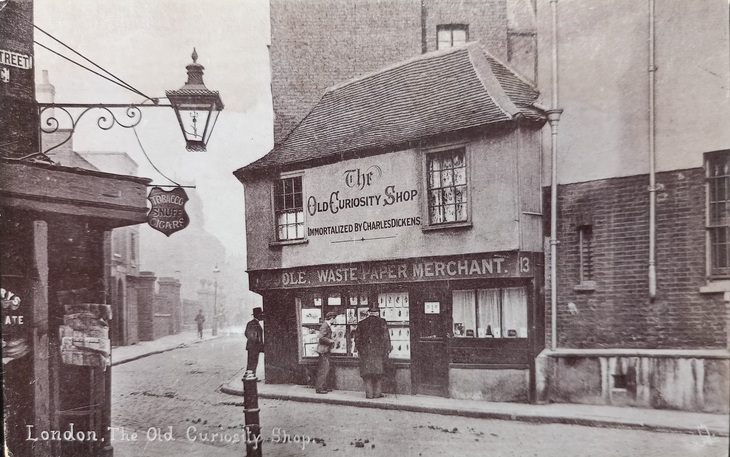For more of all things London history, sign up for our new (free) newsletter and community: Londonist: Time Machine.

Louisa May Alcott, author of Little Women, visited London as a tourist in 1866, a self-declared 'spinster on the rampage’ in the mid-Victorian metropolis. She particularly sought out places mentioned in Dickens's fiction and wrote in her diary that she "felt as if I'd got into a novel".
Alcott was an enormous fan of Dickens, capable of quoting long passages by heart, and even went to see him perform his public readings. She was disappointed with the ageing writer's dandyish appearance, writing to a friend: "Why will he wear two rivers of watch guards, meandering over his vest, a diamond ring on each hand, curl his gray hair and come upon the stage with a youthful skip? Oh, why?". But the sights and sounds of 'Dickens' London' — along with more traditional destinations like the Tower of London, St Paul's and Windsor Castle — filled her with delight. Alcott was something of a pioneer — the first documented Dickensian tourist and topographer. She immediately published a lightly fictionalised account of her metropolitan adventures. This began a tourist trend that has lasted for 150 years — exploring 'Dickensland'.

The death of Dickens in 1870, and his literary canonisation in Poet's Corner, Westminster Abbey, made Dickensian sites seem particularly iconic — relics of 'Old London' which the great author had immortalised for posterity. The ever-increasing numbers of American tourists visiting the capital also helped. Guides loitered in the new grand hotels that attracted the wealthiest visitors, ready to take them on literary tours. In the 1880s, Edith Davies formed the Lady Guides Association which supplied 'intelligent gentlewoman' who could escort visiting female tourists around the capital's shops, cafés and the key sights. The company promised they would provide lady guides 'acquainted with every single place of which mention is made in the great novelist's works'. Davis laid on numerous other tours and visits. This included — as early as 1890 — arranging female-led rambles around Jack the Ripper's Whitechapel. Nonetheless, 'Dickens's London' was perennially in demand, particularly among transatlantic clients.

Each passing year brought new guidebooks, travelogues, newspaper articles, magazine pieces, not to mention magic lantern shows, collectible cigarette cards and, in due course, silent films (see, for example, Dickens' London, available via the BFI). Visitors were conveyed in horse-drawn 'wagonettes' from the walls of the Marshalsea Gaol to the so-called 'Old Curiosity Shop' near Lincoln’s Inn Fields, and beyond. The East End — for a few years, at least — even boasted the original of the opium den described in The Mystery of Edwin Drood. The proprietress, 'Lascar Sal', was happy to entertain tourists, 'to witness the opium smoking'. Sal reportedly sold the original 'unseemly bed' featured in the novel to an American collector — its whereabouts now unknown.

Pubs, naturally enough, were particularly keen to play the Dickens card. Take the George Inn in Southwark, whose elderly proprietress, Agnes Murray, insisted that Dickens once had a regular table in the corner. A press advert from her tenure — she inherited the tenancy from her mother in 1903 and died in 1934 — reads, "DICKENS knew the worth of real comfort and good fare: try them yourself at a DICKENS INN. Good bedrooms, excellent cooking, and English meat. Retired, quaint, old fashioned, yet close to modern business needs."

The biggest attraction, however, was undoubtedly the 'Old Curiosity Shop'. The quaint cottage-like building in Portsmouth Street, dating back to the 1500s, had no known connection to the author or his work — but it did not matter. True, virtually every antique shop in London boasted of being the Old Curiosity Shop. But the proprietor's genius idea was simply to add the words 'THE OLD CURIOSITY SHOP – IMMORTALIZED BY CHARLES DICKENS' in ornate gothic script to the timbered facade. Tourists were convinced. When the building was threatened with demolition in 1883, it achieved national and international fame. Merchandise was soon available — wooden blocks, painted with a picture of the facade, sold for tuppence plain and four pence coloured. By the 1920s, visitors could buy a wide range of memorabilia, postcards and gifts, or have sets of Dickens novels shipped back home, complete with 'Old Curiosity Shop' bookplates. This was, in other words, a Dickens gift-shop — long before the modern era of brands and merchandising. The shop's popularity only declined later in the century, eclipsed by the more authentic Dickens Museum in Doughty Street, first opened in 1925.

Dickens tourism, of course, continues to this day, even as we come to know the books more through film and television adaptations —- it has become, in itself, a London tradition. Late Victorian newspapers dubbed literary tourists 'The Dickens Cult' – and we still worship at his real and imagined shrines.

Dickensland by Lee Jackson, published by Yale University Press, available now in hardback



